The Discovery of Nature’s Master Timekeeper
Why do we sleep, wake and eat when we do? Brandeis biologists Michael Rosbash and Jeff Hall looked deep inside cells and found the answer. In October, they were rewarded for their breakthroughs — with the Nobel Prize.
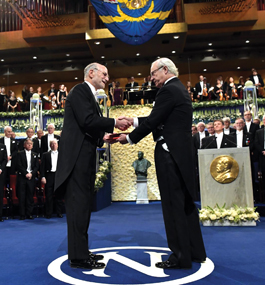
Jonas Ekstromer / AFP / Getty Images
Michael Rosbash receives his Nobel medallion from King Carl XVI Gustaf of Sweden.
by Lawrence Goodman
Drying off in the locker room after a basketball game in 1982, biologists Michael Rosbash and Jeff Hall were discussing the behavior of fruit flies. Hall had researched flies since college and loved the tiny insects. He was interested in the period gene, or “per” for short, located on the insect’s X chromosome. Hall believed this single gene could explain many of the daily fly activities linked to the animal’s circadian rhythms, including sleep, wakefulness, eating, courtship and reproduction.
Rosbash and Hall had been fast friends since arriving at Brandeis eight years earlier as 30-year-old assistant professors. They shared an interest in politics, rock ’n’ roll and sports. But they had yet to collaborate on a research project. Hall was a geneticist by training; Rosbash, a molecular biologist. At work, they focused on separate topics, taking different approaches.
A telephone company crew assigned to the Waltham area regularly joined Rosbash and Hall in their noontime basketball game. They were growing tired of listening to the professors debate what per did or did not do. “Why don’t you go and figure it out already?” one of the workers asked them.
“OK,” Rosbash said. “It’s time. Let’s do it.”
Though they couldn’t know it then, Rosbash and Hall would go on to explain one of the great scientific unknowns — why almost every organism is biologically in sync with the Earth’s rotation around the sun. Per turned out to be part of a master clock inside cells that keeps the biological processes collectively known as circadian rhythms on a 24-hour cycle.
A raft of physiological processes are connected to the per gene, not just outward behavior like sleeping, but biological functions like the ebb and flow of hormones, the rise and fall of body temperature, and changes in blood pressure and metabolism. If these processes didn’t revolve around sunrise and sunset, life would never have evolved on Earth in the first place.
In October, Rosbash, 73, and Hall, 72, were awarded the Nobel Prize in Physiology or Medicine for their research in circadian rhythms. Rosbash holds the Peter Gruber Endowed Chair in Neuroscience. Hall, who left Brandeis in 2008, is professor emeritus of biology. Michael Young at The Rockefeller University, whose laboratory did its own independent, important research on the biological master clock, shared in the award.
Rosbash and Hall “represent the innovation and collaboration that Brandeis has been known for since its founding,” President Ron Liebowitz said at a press conference at Brandeis on Oct. 2, the day the Nobel Committee announced the 2017 recipients. “This Nobel Prize is a fitting testament to their remarkable work, which has changed our understanding of the rhythms of life.”
The Nobel Prize also affirms the value of basic research, the lifeblood of science at Brandeis. Researchers in the life sciences collaborate to understand the most fundamental biological processes, even though the research may not at the outset seem relevant to humans. When they began their collaboration, Rosbash and Hall didn’t know whether per in one form or another existed in life-forms other than insects. It turned out to be widespread among organisms, including humans.
 |
|
Sidebar Story |
 |
Rosbash and Hall’s discoveries paved the way for huge advances in understanding human health and illness. We now know that abnormal circadian rhythms are probably linked to Alzheimer’s, diabetes, heart disease and mental illness. When circadian rhythms fall out of sync, permanent jet lag results.
“The idea that studying the activity patterns of an insect would have an impact on human health was not something many people would have thought of 25, 30 years ago, but it has,” Leslie Griffith, the Nancy Lurie Marks Professor of Neuroscience, said at the press conference. “Jeff and Michael’s partnership really made them an unbeatable team.”
A new urgency
Rosbash was born in Kansas City, Missouri, and grew up in Brookline and Newton, Massachusetts. His mother and father were born in Germany and planned to become a doctor and a lawyer, respectively, until the Nazis started restricting the number of Jews in German universities in 1933. His father became a cantor, landing a job at a temple in northern Germany. He thought Nazism would blow over. His wife believed otherwise. She told him she was leaving for the United States with or without him. He wisely decided to join her.
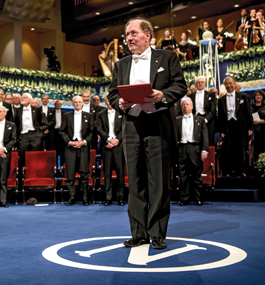
Alexander Mahmoud / © Nobel Media AB
Jeff Hall at the Nobel ceremony.
page 2 of 5
When Rosbash was 2, his father got a job at Temple Ohabei Shalom, a Reform synagogue in Brookline. He dreamed of becoming an opera singer in the style of Jan Peerce, a Lower East Side Jew who became a star tenor. In summer 1954, Ed Sullivan heard Rosbash’s father sing at a B’nai B’rith event in the Boston area and asked him to perform on his show that fall.
It never happened. On Yom Kippur eve, a few weeks before his scheduled TV debut, Rosbash’s father felt severe chest pains while singing the Kol Nidre prayer. He walked backstage and suffered a fatal heart attack. Rosbash’s mother had been preparing to enter medical school that fall. Instead, she became a cytologist to support the family. She never mentioned her husband in front of her children again.
Rosbash was 10 when his father died. The loss “not only left me without a father and male role model but also shook our nuclear family to its core,” he wrote in an autobiographical essay published in November in the journal Cell. “I was set adrift and had a hard time finding some emotional center of gravity.”
His report cards from grade school show him to be an excellent but unruly student. A third-grade teacher said he was a “very disturbing influence” in the classroom. The next year, another teacher wrote, “If Michael makes a request and it is not immediately granted, he is inclined to be very insistent.”
By the time he was ready for college, Rosbash wanted to get as far from home as possible. He went to Caltech for a Bachelor of Science then headed back east to earn a PhD at MIT.
Soon after he came to Brandeis, Rosbash had what he has called a “religious conversion” discovering “the awesome power of genetics.” He grew skilled at using cutting-edge recombinant DNA technology that allowed scientists to isolate and manipulate individual genes. He published prolifically, including in Cell and Nature, among the most prestigious science journals. His research established yeast as an important model for understanding the interaction between genes and ribosomal proteins inside cells. He was bound for a stellar career in science, even before he met Hall.
But the personality traits that had gotten him into trouble in grade school persisted. “I had a big mouth, was rowdy and, most importantly, really disliked authority,” he wrote in the recent Cell article. This didn’t handicap him at Caltech and MIT because both institutions “were filled with weird characters and were remarkably tolerant meritocracies. If you could perform, everyone ignored all but the worst behavioral issues.”
However, when Rosbash came up for tenure at the Rosenstiel Basic Medical Sciences Research Center in 1982, he was rejected. He’d rubbed a number of people the wrong way over the years. Some supporters insisted too much attention was being paid to personal issues and not enough to Rosbash’s stellar professional record. His case landed on the desk of Brandeis President Marver Hillel Bernstein for adjudication. Bernstein ruled Rosbash should get tenure in the biology department, not the Rosenstiel Center.
On the day he moved from Rosenstiel to the Bassine Science Building, which housed the biology department, Rosbash suffered a serious heart attack. After recovering, realizing he had almost followed in his father’s footsteps, he felt a new urgency to push forward in his collaboration with Hall. By chance, this now proved a lot easier. Rosbash had been assigned an office and a lab adjacent to Hall’s.
Lord of the flies
Hall got interested in science during high school in Bethesda, Maryland. His father, an Associated Press reporter, taught him about Washington politics, but his biology and chemistry instructors were the teachers who stirred his imagination. He went to Amherst College, where he majored in biology, studying with geneticist Philip Ives.
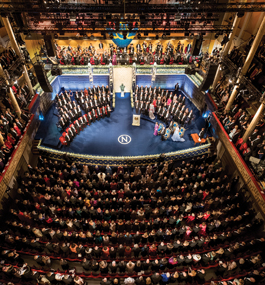
Alexander Mahmoud / © Nobel Media AB
The 2017 Nobel ceremony.
page 3 of 5
While working with Ives, Hall’s lifelong love affair with the fruit fly began. Drosophila melanogaster, as fruit flies are known scientifically, have been used as a model organism for more than a century. Humans and Drosophila share most of their genes; 80 percent of human-disease genes are present in fruit flies. Flies reproduce several times over their 40- to 50-day life span. All this makes them an exceptional model in which to study human disease.
After Amherst, Hall earned a PhD in biology at the University of Washington, in Seattle. Legendary biologist Herschel Roman recommended him for a postdoc in the lab of another legendary scientist, Caltech’s Seymour Benzer. Benzer revolutionized genetics by showing that genes didn’t just help determine characteristics and traits like height or eye color, they helped determine behavior. By breeding various strains of mutant fruit flies, he proved genes play a role in sensitivity to stress, sexual function, and learning and memory.
In the late 1960s and early ’70s, Benzer and graduate student Ronald Konopka conducted a series of experiments that would prove seminal to Rosbash and Hall’s future research. Benzer and Konopka doused thousands of fruit flies in toxic chemicals that induced genetic mutations. The offspring of these ill-fated insects were then observed over the course of 24 hours.
Most behaved as flies typically do, with bursts of activity at dawn and dusk, and rest periods in between. But some carried out this behavior over the course of 19 hours. Others followed a 28-hour cycle. It was clear their internal biological clocks were off. Their circadian rhythms weren’t occurring over a 24-hour period.
By examining the flies’ genetic mutations, Benzer and Konopka linked the proper functioning of the internal clock to the per gene. Per was important to the fruit fly, controlling its circadian rhythms. When per was mutated, the fruit fly’s internal clock was no longer in sync with the Earth’s revolution around the sun.
At the time, Benzer and Konopka’s findings seemed to apply only to flies and lacked a clear explanation. All the same, a small group of scientists, including Hall, were convinced Benzer and Konopka had forever changed the field of behavioral genetics.
Hall joined Benzer’s lab in 1971, right before the paper on per was published. Though he sometimes sparred with Benzer, he grew familiar with Benzer’s work on circadian rhythms and imbibed his belief in the power of genes to influence behavior. Shortly before Hall left to join Brandeis, he began a new research project on the fruit fly’s mating rituals.
When Drosophila court, the male gropes the female with his forelegs, sings to her, then licks her posterior region. The singing is actually the sound of his wings flapping and vibrating. To human ears, it’s a dull series of chirps with soft static in between, but to female flies it’s pure Barry White.
Charalambos Kyriacou, one of Hall’s postdocs, recorded a few minutes of each male fruit fly’s mating song and started looking for patterns in the signal. A paper printout of the song of a single male stretched over 100 yards. Kyriacou detected a previously unrecognized one-minute cycle in the male’s courtship signal. Could a biological clock be responsible for the rhythm’s duration, and was that clock driven by the per gene?
Hall and Kyriacou obtained the per gene mutants Benzer and Konopka used in their experiments. Further studies revealed that flies with altered circadian rhythms showed corresponding changes in their mating songs. Mutant flies with circadian rhythms longer than 24 hours had song rhythms longer than a minute. For flies with circadian rhythms shorter than 24 hours, the reverse was true.
The results showed clearly that circadian rhythms and fly mating songs were connected via the per gene. Hall and Kyriacou published their results in 1980. Kyriacou left Brandeis in 1981 for a position in Scotland, and soon afterward Hall and Rosbash joined forces.
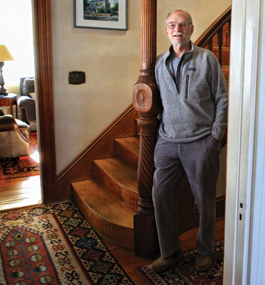
Mike Lovett
Rosbash at home in Newton, Massachusetts.
page 4 of 5
Brilliant minds and insatiable curiosity
As partners, Rosbash and Hall were well-suited to each other. Rosbash worked with a singular focus and intensity that allowed him to dive deeply into a problem. Hall brought breadth of knowledge to the collaboration. His memory enabled him to conjure references to decades-old scientific papers seemingly out of nowhere. (He also possessed amazing recall of sports statistics, pop-music lyrics and snippets of dialogue from movies. Fittingly, he decorated his Brandeis office with stills from the 1950s horror film “The Fly.”)
“Michael and Jeff are brilliant minds,” says Vipin Suri, PhD’01, who worked with them. “They were remarkable for their insatiable curiosity, the depth of their scientific efforts, the pace of thought and execution, and a leave-no-stone-unturned mentality.”
Both men also shared a rebellious streak. At a 1976 faculty meeting, when Hall stood up to deliver a speech, Rosbash fired a seltzer bottle at him. The prearranged practical joke went awry when Rosbash misfired and doused himself. It was a funny prank but probably not the best move for two assistant professors trying to get tenure.
In 1984, Rosbash and Hall reported in Cell that they had successfully cloned the per gene. At this point, Rosbash’s postdoc Paul Hardin, now at Texas A&M University, relocated his experiments to Bassine’s windowless basement, known as “The Pit.” The lack of natural sunlight gave Hardin a controlled environment where he could place thousands of flies in an incubator and use an electric light to set the length of night and day. For 12 hours, the flies had light; for the next 12, darkness.
At various times during the cycle, Hardin removed groups of flies and froze the specimens in liquid nitrogen. Because flies’ necks are extremely brittle, when Hardin shook the tubes of frozen flies, their necks snapped. The heads, full of neurons that express the per gene, could be isolated using a fine-mesh sieve. The purified fly heads were stored in a chemical solution that caused the brain cells to break apart. In the soup made up of molecules from these cells, Hardin found what he was looking for — the per gene’s messenger RNA (mRNA).
Hall’s postdoc Kathy Siwicki worked to identify the protein connected to per. She developed a novel antibody that penetrated a fruit fly’s cell and stained certain cellular components. Under a microscope, the protein encoded by per revealed itself. In accordance with standard nomenclature, its name became a capitalized form of its associated gene: PER.
PER turned out to be composed of a sequence of building blocks — amino acids — unlike any other known protein. “We were working in uncharted territory, with a protein that was completely novel,” says Siwicki, now a professor at Swarthmore College. “It was a pretty intense emotional experience.” For several months, she often worked six days a week, 12 hours a day.
Over the next several years, Rosbash, Hardin, Hall and several other colleagues figured out how the puzzle pieces fit together. A self-regulating cycle was at work inside the fly cells. First, the per gene gave instructions to the mRNA. Second, the mRNA caused the production of PER. Third, PER molecules traveled back into the cell nucleus and turned off the activity of the per gene. PER was then degraded by light in the early morning, effectively resetting the entire process. Once the PER disappeared, the per gene started working again, encoding mRNA.
The whole process — the per gene to mRNA to PER and then back to the per gene — is a feedback loop. It takes place over the course of 24 hours and then repeats. Hall and Rosbash had discovered the molecular machinery responsible for advancing the hands of the fly’s biological clock. Hardin would later say they’d found what causes the clock to go ticktock. Young, at Rockefeller, discovered other genes involved in the feedback loop.
It was the culmination of an era in fly research. Rosbash’s and Hall’s labs felt a huge sense of accomplishment. The most fundamental molecular mechanisms driving the master biological clock had been elucidated. “We had the circadian clock on its knees,” says Hall. “It had thrown up its hands and said, ‘You found me out.’”
Over the next several years, other researchers showed that the master biological clock in mammals functioned the same way as the fly’s. In humans, the difference is that there are several per genes.
The ubiquity of 24-hour circadian rhythms suggests they were one of the first evolutionary adaptations of living organisms to their environment. Once the biological clock developed, life-forms could take full advantage of the sun. Says Hall, “Circadian rhythms are the reason there’s life on the third rock from the sun.”
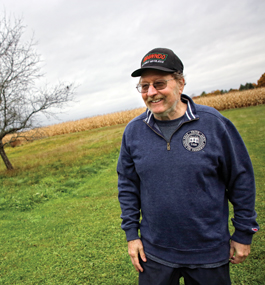
Mike Lovett
Hall at home in Cambridge, Maine.
page 5 of 5
A time to collaborate, a time to separate
By the late 1990s, Hall and Rosbash had begun to grow apart professionally.
Rosbash continued working on circadian rhythms along with the molecular-biology research he’d been pursuing apart from Hall over the previous three decades. In 1989, he became a Howard Hughes Medical Institute (HHMI) investigator with a significant annual budget for his research.
His lab has grown significantly in the almost 30 years since the HHMI appointment. He enjoys a high profile in the scientific community. He’s friends with some of the most prominent researchers in the world, a number of whom he has known since his student days.
Rosbash has also mellowed. He has a family. He no longer walks around with a chip on his shoulder. In a way, his success has made him one of the authority figures he used to rebel against. His view of the scientific profession has evolved. “I can make a bigger difference,” he says, “by working from the inside.”
Hall, meanwhile, started riding a Harley-Davidson motorcycle and wearing leather boots to work. In a 2008 interview in Current Biology, he was quoted as saying his profession had changed. The new rules put a premium on publishing in high-profile journals. Hall didn’t like navigating all the politics and the constant searching for grant money, which he felt were required to succeed.
In 2008, he left Brandeis for the University of Maine, in Orono, retiring altogether a few years later. He says today he bowed out of academia because his grant money was decreasing and he didn’t want to wind up “research-less deadwood anywhere.” He felt he’d done much of his best work and needed to move on. “No career lasts forever,” he says.
When Hall got the call from the Nobel Committee at 5:30 a.m. on Oct. 2, he was at home in Cambridge, Maine, population 500. In a farmhouse edged by cornfields, seven Jack Russell terriers keep him company. Besides forays into town to shop or pick up dog food, he has almost no social interaction. Even now, he says, only a handful of people in town know he is a Nobel laureate.
Hall says he’s very happy spending his days reading, listening to music, watching movies on television and, in warm weather, going for a ride on one of his three Harleys. “I’m never bored,” he says. He likes being free to do as he pleases or sit around staring into space. Though he found it wrenching to have to kennel his dogs for a week, he decided to go to Sweden for the Nobel ceremonies.
In his second-story lab in the Shapiro Science Center, Rosbash now researches sleep, a natural follow-up to circadian rhythms. Even though we spend about a third of our lives sleeping, we know very little about why we do it. Rosbash calls sleep “one of the great mysteries of neuroscience.” Circadian rhythms clearly play a significant role in sleep regulation; the cycle of alertness and rest occurs in many species over the course of 24 hours.
Two years ago, in the journal Nature, Rosbash’s lab reported a breakthrough. Once again working in flies, Rosbash and his colleagues identified the first-known sleep-promoting circadian cells in the insect’s brain. These cells work by inhibiting circadian cells that cause wakefulness.
In early December, Rosbash and Hall traveled to Stockholm to receive their Nobel Prize. For two weeks, they were treated like Swedish royalty — chauffeured everywhere, assigned a personal attaché from the Swedish government, lodged at the five-star Grand Hôtel overlooking the Royal Palace and the Baltic Sea. Men at the Nobel award ceremony at the Stockholm Concert Hall wore white tie and tails; the women wore evening gowns. Sweden’s king, Carl XVI Gustaf, handed Rosbash and Hall their Nobel medallions. As custom requires, the researchers bowed three times: first, to the king; then to previous laureates and Nobel Committee members; last, to the audience.
Afterward, at the banquet, Rosbash delivered a short speech on behalf of himself, Hall and Young. His remarks extolling the values of a pluralistic America where immigrants are welcome made international headlines. He ended, though, by expressing appreciation to the Nobel Committee.
“We have been blessed with good fortune at almost every turn,” he said. “Yet to have this journey topped off in this way is almost unimaginable.”
